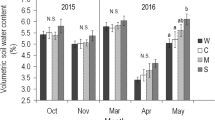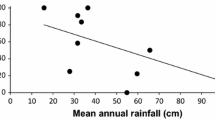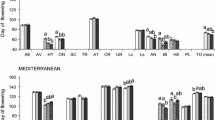Abstract
The mechanisms by which global change alters the genotypic structure of populations by selection remain unclear. Key to this understanding is elucidating genotype–phenotype relationships under different environmental conditions as genotypes could differ in their plasticity or in their tolerance to changing environmental conditions. We have previously observed selection of certain genotypes of the dominant C4 grass Andropogon gerardii L. within the on-going Rainfall Manipulation Plots (RaMPs) experiment at Konza Prairie Biological Station in Kansas. The RaMPs experiment has been experimentally imposing ambient and more variable (altered) precipitation patterns since 1998. Here, we studied phenotypic differences among six genotypes to gain insight into what drove the pattern of selection previously observed and assess potential genotype × environmental interactions. In 2008 and 2009 we sampled individuals of genotypes in the RaMPs and within unmanipulated reference plots located adjacent to the RaMPs experiment. For each individual, we measured both leaf-level (specific leaf area, stomatal conductance) and whole-plant growth (height, biomass) traits. We consistently detected differences among genotypes in the reference plots. Additionally, when focusing on two genotypes found in the altered and ambient RaMPs we observed no genotype × environment interactions. Overall, we found in an intact population of A. gerardii there exists phenotypic variability among genotypes, but no genotype × environment interactions. Thus our results demonstrate that differences in plasticity of genotypes do no explain the pattern of selection we observed.




Similar content being viewed by others
References
Ackerly D, Dudley S, Sultan S, Schmitt J, Coleman J, Linder C, Sandquist D, Geber M, Evans A, Dawson T, Lachowicz M (2000) The evolution of plant ecophysiological traits: recent advances and future directions. Bioscience 50(11):979–995
Avolio MA, Smith MD (2013) Mechanisms of selection: phenotypic differences among genotypes explain patterns of selection in a dominant species. Ecology 94:953–965
Avolio ML, Chang CC, Smith MD (2011) Assessing fine-scale genotypic structure of a dominant species in native grasslands. Am Midl Nat 165:211–224
Avolio ML, Beaulieu JM, Smith MD (2013) Genetic diversity of a dominant C4 grass is altered with increased precipitation variability. Oecologia 171:571–581
Benson EJ, Hartnett DC (2006) The role of seed and vegetative reproduction in plant recruitment and demography in tallgrass prairie. Plant Ecol 187(2):163–177
Bradshaw A (1965) Evolutionary significance of phenotypic plasticity in plants. Adv Genet 13:115–155
Chang CC, Smith MD (2012) Invasion of an intact plant community: the role of population versus community level diversity. Oecologia 168:1091–1102
Chaves MM (1991) Effects of water deficits on carbon assimilation. J Exp Bot 42(234):1–16
Chaves MM, Maroco JP, Pereira JS (2003) Understanding plant responses to drought—from genes to the whole plant. Funct Plant Biol 30(3):239–264
Cornelissen JHC, Lavorel S, Garnier E, Diaz S, Buchmann N, Gurvich DE, Reich PB, Steege H, Morgan HD, Heijden MGA, Pausas JG, Poorter H (2003) A handbook of protocols for standardised and easy measurement of plant functional traits worldwide. Aust J Botany 51:335–380
Diaz S, Cabido M (1997) Plant functional types and ecosystem function in relation to global change. J Veg Sci 8:463–474
Etterson J, Shaw R (2001) Constraint to adaptive evolution in response to global warming. Science 294:151–154
Fay PA, Carlisle JD, Knapp AK, Blair JM, Collins SL (2000) Altering rainfall timing and quantity in a mesic grassland ecosystem: design and performance of rainfall manipulation shelters. Ecosystems 3:308–319
Fay PA, Kaufman DM, Nippert JB, Carlisle JD, Harper CW (2008) Changes in grassland ecosystem function due to extreme rainfall events: implications for responses to climate change. Global Change Biol 14(7):1600–1608
Fay PA, Blair JM, Smith MD, Nippert JB, Carlisle JD, Knapp AK (2011) Relative effects of precipitation variability and warming on tallgrass prairie ecosystem function. Biogeosciences 8:3053–3068
Gienapp P, Teplitsky C, Alho JS, Mills JA, Merila J (2008) Climate change and evolution: disentangling environmental and genetic responses. Mol Ecol 17(1):167–178
Grime JP (2001) Plant strategies, vegetation processes, and ecosystem properties, 2nd edn. Wiley, New York
Gustafson DJ, Gibson DJ, Nickrent DL (2004) Competitive relationships of Andropogon gerardii (Big Bluestem) from remnant and restored native populations and select cultivated varieties. Funct Ecol 18(3):451–457
Hartman JC, Nippert JB, Springer CJ (2012) Ecotypic responses of switchgrass to altered precipitation. Funct Plant Biol 39:126–136
Hughes AR, Stachowicz JJ, Williams SL (2009) Morphological and physiological variation among seagrass (Zostera marina) genotypes. Oecologia 159(4):725–733
IPCC (2007) Climate change 2007: the physical science basis. In: Contribution of working group I to the fourth assessment report of the Intergovernmental Panel on Climate Change. Cambridge University Press, Cambridge
Johnson MTJ, Dinnage R, Zhou AY, Hunter MD (2008) Environmental variation has stronger effects than plant genotype on competition among plant species. J Ecol 96:947–955
Jump AS, Penuelas J (2005) Running to stand still: adaptation and the response of plants to rapid climate change. Ecol Lett 8(9):1010–1020
Knapp AK, Briggs JM, Hartnett DC, Collins SL (1998) Grassland dynamics. Oxford University Press, New York
Knapp AK, Fay PA, Blair JM, Collins SL, Smith MD, Carlisle JD, Harper CW, Danner BT, Lett MS, McCarron JK (2002) Rainfall variability, carbon cycling, and plant species diversity in a mesic grassland. Science 298(5601):2202–2205
Knapp A, Beier C, Briske D, Classen A, Luo Y, Reichstein M, Smith M, Smith S, Bell J, Fay P (2008) Consequences of more extreme precipitation regimes for terrestrial ecosystems. Bioscience 58(9):811–821
Lauenroth WK, Adler PB (2008) Demography of perennial grassland plants: survival, life expectancy and life span. J Ecol 96(5):1023–1032
Miner B, Sultan S, Morgan S, Padilla D, Relyea R (2005) Ecological consequences of phenotypic plasticity. Trends Ecol Evol 20:685–692
Nippert JB, Fay PA, Carlisle JD, Knapp AK, Smith MD (2009) Ecophysiological responses of two dominant grasses to altered temperature and precipitation regimes. Acta Oecol 35:400–408
Pan JJ, Price JS (2001) Fitness and evolution in clonal plants: the impact of clonal growth. Evol Ecol 15(4–6):583–600
Proffitt C, Travis S, Edwards K (2003) Genotype and elevation influence Spartina alterniflora colonization and growth in a created salt marsh. Ecol Appl 13(1):180–192
Reich P, Walters M, Ellsworth D (1997) From tropics to tundra: global convergence in plant functioning. Proc Natl Acad Sci USA 94(25):13730–13734
Schulze ED (1986) Whole plant responses to drought. Aust J Plant Physiol 13(1):127–141
Seliskar DM, Gallagher JL, Burdick DM, Mutz LA (2002) The regulation of ecosystem functions by ecotypic variation in the dominant plant: a Spartina alterniflora salt-marsh case study. J Ecol 90(1):1–11
Smith MD, Knapp AK (2003) Dominant species maintain ecosystem function with non-random species loss. Ecol Lett 6(6):509–517
Smith MD, Knapp AK, Collins SL (2009) A framework for assessing ecosystem dynamics in response to chronic resource alterations induced by global change. Ecology 90:3279–3289
Tomas F, Abbott JM, Steinberg C, Balk M, Williams SL, Stachowicz JJ (2011) Plant genotype and nitrogen loading influence seagrass productivity, biochemistry, and plant–herbivore interactions. Ecology 92:1807–1817
Valladares F, Gianoli E, Gomez J (2007) Ecological limits to plant phenotypic plasticity. New Phytol 176:749–763
Vitousek PM (1994) Beyond global warming—ecology and global change. Ecology 75:1861–1876
Vos P, Hogers R, Bleeker M, Reijans M, Vandelee T, Hornes M, Frijters A, Pot J, Peleman J, Kuiper M, Zabeau M (1995) Aflp—a new technique for DNA-fingerprinting. Nucleic Acids Res 23(21):4407–4414
Weaver JE (1954) North American prairie. Johnsen Publishing, Lincoln
West-Eberhard M (1989) Phenotypic plasticity and the origins of diversity. Annu Rev Ecol Syst 20:249–278
Westoby M, Falster D, Moles A, Vesk P, Wright I (2002) Plant ecological strategies: some leading dimensions of variation between species. Annu Rev Ecol Syst 33:125–159
Wilson P, Thompson K, Hodgson J (1999) Specific leaf area and leaf dry matter content as alternative predictors of plant strategies. New Phytol 143:132–155
Acknowledgments
Support was provided to M.D.S. by the US Department of Energy, Office of Science (PER) (Grant #DE-FG02-04ER63892) and an EPA STAR to MA. Additional support was provided by the USDA CREES Ecosystem Studies Program, the NSF Ecosystems and LTREB programs (Grant #DBI-04214427). We thank Jesse Nippert for his advice on the physiological measurements. We also thank Patrick O’Neal, Jeffery Taylor and the RaMPs Crew as well as Alan Knapp, John Blair and Scott Collins. Additionally, we thank Cynthia Chang, Kimberly La Pierre, Sally Koerner, David Hoover, and Tory Nelson for their assistance in the field. This manuscript was improved by comments from Jesse Nippert, and Oswald Schmitz and two anonymous reviewers.
Author information
Authors and Affiliations
Corresponding author
Appendix
Appendix
See Fig. 5.
Rights and permissions
About this article
Cite this article
Avolio, M.L., Smith, M.D. Intra-specific responses of a dominant C4 grass to altered precipitation patterns. Plant Ecol 214, 1377–1389 (2013). https://doi.org/10.1007/s11258-013-0258-y
Received:
Accepted:
Published:
Issue Date:
DOI: https://doi.org/10.1007/s11258-013-0258-y





